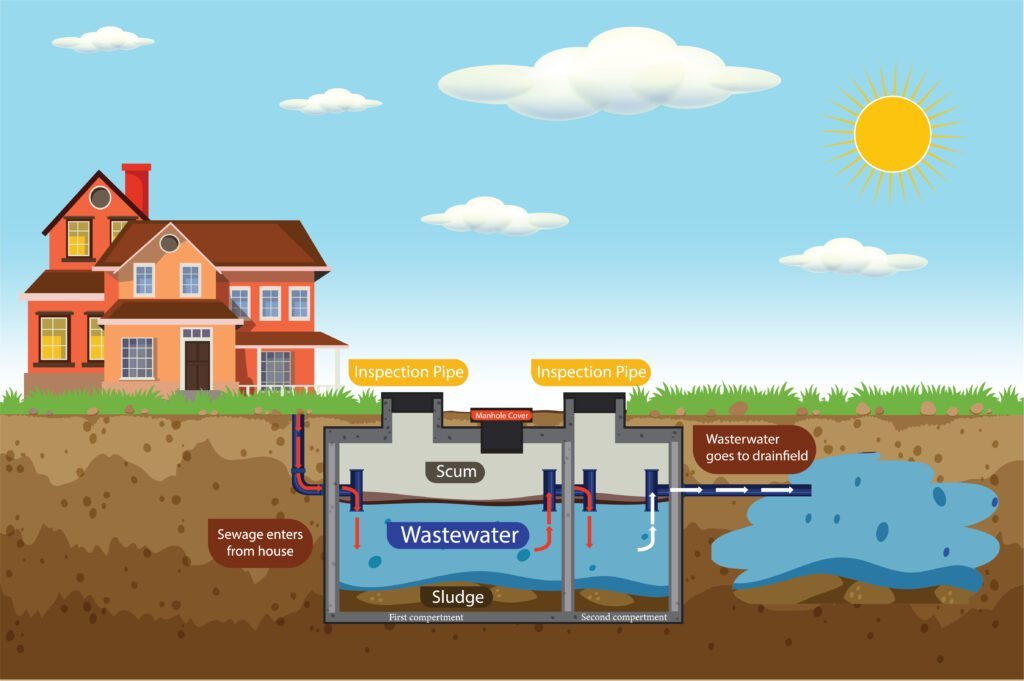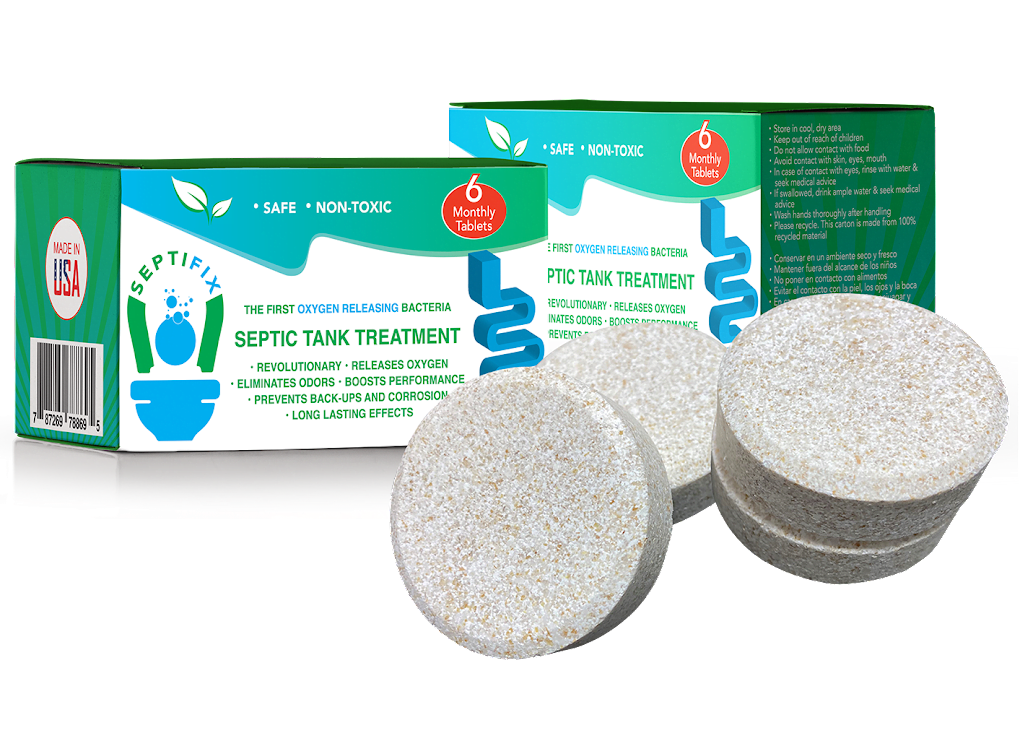Septic Tank System explained:

Chapter 1: What is a Septic Tank System?
A septic tank system is a decentralized and self-contained wastewater treatment solution commonly used in areas where municipal sewer systems are not available. It serves as an on-site sewage treatment system, handling the collection, treatment, and disposal of household wastewater. To better understand how septic systems work, let’s explore their key components in detail:
- Septic Tank: This underground, watertight container is typically made of concrete, fiberglass, or plastic and is buried beneath the ground near the house. Its primary purpose is to collect and temporarily store raw sewage and wastewater from your household plumbing fixtures, including toilets, sinks, showers, and laundry machines.
- Distribution Box: Beyond the septic tank, the treated effluent (liquid waste) flows into a distribution box. This component ensures that the effluent is evenly distributed to the drainfield.
- Drainfield (Leach Field): The drainfield is the final stage of the septic system, where treated effluent is released into the soil. It consists of a network of perforated pipes or chambers buried in trenches or beds. In the drainfield, the effluent undergoes further treatment as it percolates through the soil. This process allows natural biological processes and soil microorganisms to remove remaining impurities, effectively purifying the water before it reenters the environment.
- Soil: The soil in the drainfield is crucial to the septic system’s functionality. It acts as a natural filter, providing additional treatment by removing harmful pathogens and nutrients from the effluent. The soil also helps to disperse the treated water into the environment safely.
Chapter 2: How Does a Septic Tank System Work?
Understanding the inner workings of a septic system is essential to appreciate its role in wastewater treatment:

SEPTIFIX will save you hundreds, if not thousands of dollars each year, because your septic system will run smoothly and you won’t have to worry about calling the pumpers or a plumber for a fix!
Click here to save up to 50%
- Wastewater Collection: Every time you flush a toilet, run water in a sink, take a shower, or do laundry, the wastewater flows into the septic tank through the sewer pipes.
- Separation and Treatment: Inside the septic tank, the wastewater is subjected to a separation process. Heavy solid waste particles settle to the bottom and form a layer of sludge, while lighter materials like grease and oils float to the top as scum. The remaining liquid effluent in the middle undergoes a level of treatment.
- Distribution: The partially treated liquid effluent exits the septic tank and enters the distribution box, which directs it to the drainfield. Proper distribution is crucial to ensure even flow into the drainfield pipes.
- Biological Treatment: In the drainfield, the effluent is further treated as it flows through the perforated pipes and comes into contact with the surrounding soil. Natural microorganisms in the soil break down and purify the effluent, removing harmful pathogens and contaminants.
- Final Disposal: After undergoing this final stage of treatment, the now-treated effluent reenters the groundwater, contributing to the natural water cycle and replenishing local aquifers. In some cases, it may also help irrigate plants and trees in the vicinity of the drainfield.
By following this systematic process, a septic tank system effectively manages household wastewater, allowing for the safe return of clean water to the environment.
Chapter 3: Maintenance and Care
Maintaining a septic tank system is vital to ensure its longevity and effectiveness. Here are some key maintenance tasks homeowners should be aware of:
- Regular Pumping: Over time, the solid waste (sludge) in the septic tank accumulates and needs to be pumped out by a professional. The frequency of pumping depends on factors like tank size, household size, and water usage but is typically required every 2 to 5 years.
- Effluent Filter Cleaning: Many septic systems are equipped with effluent filters to prevent solids from entering the drainfield. These filters need regular cleaning or replacement to ensure proper operation.
- Water Conservation: Excessive water usage can overload the septic system, so it’s essential to practice water conservation measures, such as fixing leaks and using water-saving appliances.
- Avoiding Harmful Substances: Avoid flushing non-biodegradable items like diapers, wipes, and sanitary products down the toilet. Additionally, minimize the use of harsh chemicals and excessive grease, as they can disrupt the septic tank’s microbial balance.
By adhering to these maintenance guidelines, homeowners can prevent costly repairs and ensure their septic systems function effectively for many years.
Chapter 4: Signs of Septic System Problems
Recognizing the signs of septic system issues is crucial for addressing problems promptly. Ignoring these signs can lead to more extensive and costly repairs. Common warning signs include:

SEPTIFIX will save you hundreds, if not thousands of dollars each year, because your septic system will run smoothly and you won’t have to worry about calling the pumpers or a plumber for a fix!
Click here to save up to 50%
- Slow Drains: If you notice slow drainage in sinks, bathtubs, or toilets throughout your home, it may indicate a potential issue with your septic system.
- Foul Odors: Unpleasant odors around the area of the septic tank or drainfield may suggest problems with the system’s integrity or ventilation.
- Pooling Water: Water pooling in your yard, especially around the drainfield area, can indicate a potential septic system failure. This could be due to a clogged drainfield or improper drainage.
- Backups and Gurgling: Sewage backups in drains or gurgling sounds when you flush toilets can signal a blockage in the plumbing or a failing septic system.
Addressing these signs promptly can prevent more severe problems and avoid the inconvenience and expense of a system failure.

Chapter 5: Environmental Impact and Regulations
Septic systems, when properly maintained and located in suitable soil conditions, are environmentally friendly. They allow for the treatment of household wastewater on-site, reducing the burden on centralized sewage treatment facilities. However, poorly maintained or failing septic systems can pose environmental risks, such as groundwater contamination and the release of harmful pathogens.
Understanding local regulations and adhering to them is essential to protect the environment and public health. Many jurisdictions have strict rules governing septic system installation, maintenance, and inspections. Compliance with these regulations helps ensure that septic systems do not harm the environment and nearby water sources.
Chapter 6: Upgrading or Replacing a Septic System
In some cases, homeowners may need to consider upgrading or replacing their septic system due to changes in household size or usage. Upgrading options may include installing an alternative septic system, such as an aerobic treatment unit (ATU) or a mound system. These systems can provide enhanced treatment and may be necessary in areas with challenging soil conditions or high water tables. When contemplating upgrades or replacements, it’s crucial to consult with septic system professionals to determine the best solution for your specific needs.
Conclusion of Septic Tank System explained.
A well-maintained septic tank system is a reliable and efficient means of wastewater treatment for homes and properties without access to municipal sewer systems. By understanding its components, operation, and maintenance requirements, homeowners can ensure their septic systems operate effectively while minimizing their environmental impact. Regular inspections, proper care, and adherence to local regulations are key to the long-term success of septic tank systems. Ultimately, a well-functioning septic system contributes to a healthier and more sustainable living environment.


